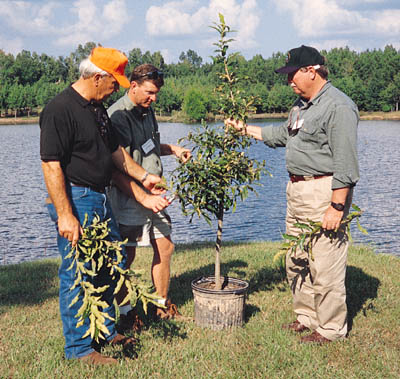Wildlife Trends—Lee County Plant Nursery Gives Birth To Wildlife Publication

When Wayne Bassett started The Wildlife Group, a nursery that produces 22 varieties of trees and other plants to attract wildlife, he had no idea it would lead him into the publishing business.But as his nursery grew, so did Bassett’s requests for information about how to best manage land for wildlife. Soon, he and his associates were producing a monthly newsletter, Wildlife Trends, to keep landowners and sportsmen informed on new developments and concepts in wildlife management.”The idea of a newsletter came to me while just sitting around and having a cup of coffee with Coach Pat Dye one evening,” said Bassett. “We were talking about how people were always asking for more information on what to plant and when to plant food to attract all types of wildlife. It wasn’t just hunters who wanted to know, either. A lot of people just like to view and photograph wildlife and birds. Attracting wildlife to their property is just as important to them as it is to someone who runs a hunting operation.” Bassett said this casual visit with the former Auburn University football coach inspired him to develop a newsletter containing articles written by respected wildlife professionals.”I discussed my idea for the newsletter with my brother, Jimmy Bassett, Dr. Lee Stribling, Andy Whitaker and Coach Dye,” Bassett recalled. “They thought it was a good idea and wanted to be a part of it. After a lot of thought and planning as to the direction we wanted to go, our newsletter, Wildlife Trends, was born.”According to Bassett, Wildlife Trends is unique because the publishers do not sell advertisements to generate revenue. “We wanted our subscribers to know right from our startup that anything we published would be strictly non-biased and authored by professional wildlife biologists and researchers,” Bassett said. “Our articles come from ‘boots and briars’ researchers who actually get out in the woods and do firsthand research. If we say something works or is a good product, it is because we know from firsthand experience. Our articles are not influenced by a paid advertisement on the next page of the newsletter,” he added.Wildlife Trends is designed to be an educational newsletter with emphasis on total wildlife management. Each issue has practical wildlife information for people who may not be schooled in wildlife management. Bassett described the publication as a “to-the-point,” reference tool for those involved in wildlife management techniques and habitat enhancement.”We cover management for deer, turkey, quail, dove, small game and fresh water fish ponds. We also have articles that cover wildlife enhancement on properties as small as your backyard,” said Bassett.Bassett said wildlife management is still a relatively young science and profession. “Fifty years ago, we had theories and concepts on wildlife management without any real scientific proof. Now, we have facts from bona fide scientific research that have resulted in new techniques as far as management for specific species,” he said. “A lot of the things we thought were true 20 years ago we are finding were not necessarily right or conditions have changed to the point these old management techniques are no longer applicable,” said Bassett.Wildlife Trends’ first edition was published in January 2001. A subscription to the newsletter costs $125 annually and includes 12 monthly issues, a library binder and a field day where wildlife professionals treat guests to lectures and demonstrations. Bassett and his associates insist that everyone conducting a seminar at the annual field day be an authority in their field. “If we have someone giving a talk on deer or turkey management, you can bet they have been involved in hands-on deer or turkey research and have field experience,” said Bassett.Subscribers recently attended a field day at White Oak Plantation, located near Tuskegee, Ala. White Oak, operated by Robert Pitman (334-727-9258), is a nationally acclaimed hunting, fishing and outdoor activities lodge renowned for its deer, turkey and quail hunting. Dr. Dan Speake, who did extensive turkey research while a professor at Auburn University, conducted a tour and lecture at a site prepared to demonstrate the ideal brood habitat for turkey poults. Dr. Speake also shared the results of surveys he conducted to improve the survival rate of young birds. Dr. Keith Causey, an authority on deer management, lectured guests on ways to supplement the whitetail deer’s nutritional needs, including a segment on free-choice feeding of soybeans to whitetails. Quail hunters and shooting preserve managers heard from Clay Sisson, who is working to increase wild quail in the South as research coordinator for the Albany (Ga.) Area Quail Management Project. Jim Evans, a wildlife biologist who has done research on releasing domestic quail into the wild, conducted a demonstration utilizing his Anchor Covey Release System.”Our first Wildlife Trends field day far exceeded our expectations,” said Bassett. “I’ve had people come up to me and tell me that just being able to hear the lectures at our field day from the wildlife authorities alone was worth the subscription price. This really makes me feel we are making a positive contribution to this country’s wildlife.”For more information about Wildlife Trends call 1-800-441-6826.
